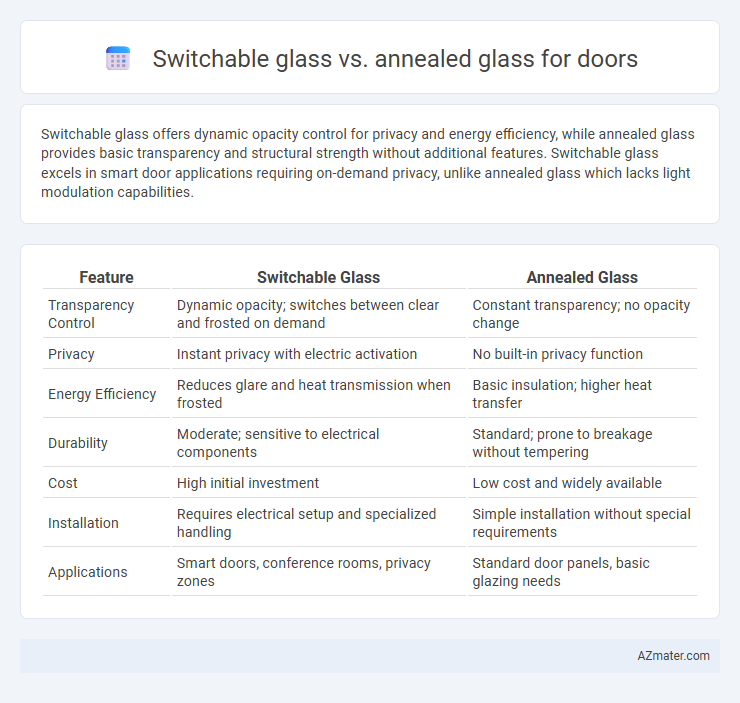Switchable glass offers dynamic opacity control for privacy and energy efficiency, while annealed glass provides basic transparency and structural strength without additional features. Switchable glass excels in smart door applications requiring on-demand privacy, unlike annealed glass which lacks light modulation capabilities.
Table of Comparison
| Feature | Switchable Glass | Annealed Glass |
|---|---|---|
| Transparency Control | Dynamic opacity; switches between clear and frosted on demand | Constant transparency; no opacity change |
| Privacy | Instant privacy with electric activation | No built-in privacy function |
| Energy Efficiency | Reduces glare and heat transmission when frosted | Basic insulation; higher heat transfer |
| Durability | Moderate; sensitive to electrical components | Standard; prone to breakage without tempering |
| Cost | High initial investment | Low cost and widely available |
| Installation | Requires electrical setup and specialized handling | Simple installation without special requirements |
| Applications | Smart doors, conference rooms, privacy zones | Standard door panels, basic glazing needs |
Introduction to Switchable Glass and Annealed Glass
Switchable glass, also known as smart glass, features electrochromic technology that allows it to change from transparent to opaque with the flick of a switch, offering privacy and energy efficiency for doors. Annealed glass is standard float glass that has been slowly cooled to relieve internal stresses, making it cost-effective but less resistant to breakage compared to tempered alternatives. Both types serve distinct purposes in door applications, with switchable glass emphasizing functionality and privacy, while annealed glass prioritizes affordability and basic transparency.
How Switchable Glass Works
Switchable glass uses a special liquid crystal film sandwiched between two glass panes that changes opacity with an electric current, allowing instant control of privacy and light transmission. When powered, the liquid crystals align to make the glass transparent, while turning off the current causes the crystals to scatter light, making the glass opaque. This technology offers dynamic privacy solutions, unlike annealed glass, which remains static and lacks adjustable transparency.
Understanding Annealed Glass
Annealed glass, commonly used for doors, undergoes a controlled slow cooling process that reduces internal stress and enhances durability while maintaining clarity and smoothness. Unlike switchable glass, which features electrochromic or polymer-dispersed liquid crystal technology to change transparency on demand, annealed glass offers consistent optical properties without the capability for light modulation. Its cost-effectiveness and structural stability make annealed glass a reliable choice for standard door applications where privacy control is not required.
Visual and Design Differences
Switchable glass offers dynamic transparency control, allowing a door to switch from opaque to clear, enhancing privacy and modern aesthetic appeal, unlike annealed glass which provides a consistent, clear appearance. The sleek, contemporary design of switchable glass integrates seamlessly in minimalist interiors, while annealed glass is more traditional, offering uniform clarity and subtle reflections. Switchable glass supports innovative lighting effects and ambience control, whereas annealed glass focuses on simplicity and durability without altering visual properties.
Privacy and Light Control Capabilities
Switchable glass offers dynamic privacy and light control by instantly changing from transparent to opaque with an electric switch, making it ideal for customizable door applications in offices and homes. Annealed glass, while clear and strong, provides no privacy control and allows full light transmission, requiring additional treatments like blinds or curtains to manage visibility and light levels. For maximum privacy and adjustable light control in door installations, switchable glass outperforms traditional annealed glass by integrating smart technology for on-demand opacity.
Safety and Security Features
Switchable glass offers enhanced privacy by instantly changing from clear to opaque, providing a security advantage for doors while maintaining visibility control. Annealed glass, though cost-effective, lacks built-in safety features such as shatter resistance, making it more prone to breakage and potential injury during impacts. Switchable glass incorporates laminated or tempered layers, significantly increasing durability and reducing the risk of forced entry compared to traditional annealed glass.
Energy Efficiency and Insulation
Switchable glass offers superior energy efficiency by actively controlling light and heat transmission, reducing reliance on external shading and HVAC systems, which significantly lowers energy consumption. In comparison, annealed glass provides basic insulation but lacks dynamic control, resulting in less effective thermal regulation and higher energy costs over time. The smart technology in switchable glass enhances insulation performance by minimizing heat loss and gain, optimizing indoor climate management for doors in both residential and commercial buildings.
Cost Comparison and Long-Term Value
Switchable glass typically costs between $50 to $100 per square foot, significantly higher than annealed glass, which ranges from $10 to $25 per square foot. Despite the upfront price, switchable glass offers enhanced privacy control and energy efficiency, potentially reducing heating and cooling costs over time. Annealed glass, while cheaper initially, lacks these smart features, resulting in lower long-term value for modern door applications prioritizing technology integration and energy savings.
Installation and Maintenance Requirements
Switchable glass requires professional installation due to its electrical components and wiring needs, ensuring proper integration with power sources and control systems. Maintenance involves regular checks of electrical connections and cleaning with non-abrasive materials to prevent damage to the conductive layers. Annealed glass has simpler installation, typically fitting standard door frames without additional electrical setup, and demands minimal maintenance apart from routine cleaning and inspections for cracks or chips.
Choosing the Right Glass for Your Door
Switchable glass offers dynamic privacy control and energy efficiency by changing from clear to opaque with an electric charge, making it ideal for modern doors requiring versatility and style. Annealed glass, a traditional option, provides strength and clarity but lacks the adaptive features of switchable glass, suitable for doors where fixed transparency is preferred. When choosing the right glass for your door, consider factors such as privacy needs, energy savings, maintenance, safety standards, and budget constraints to determine the best performance and aesthetic fit.

Infographic: Switchable glass vs Annealed glass for Door
 azmater.com
azmater.com